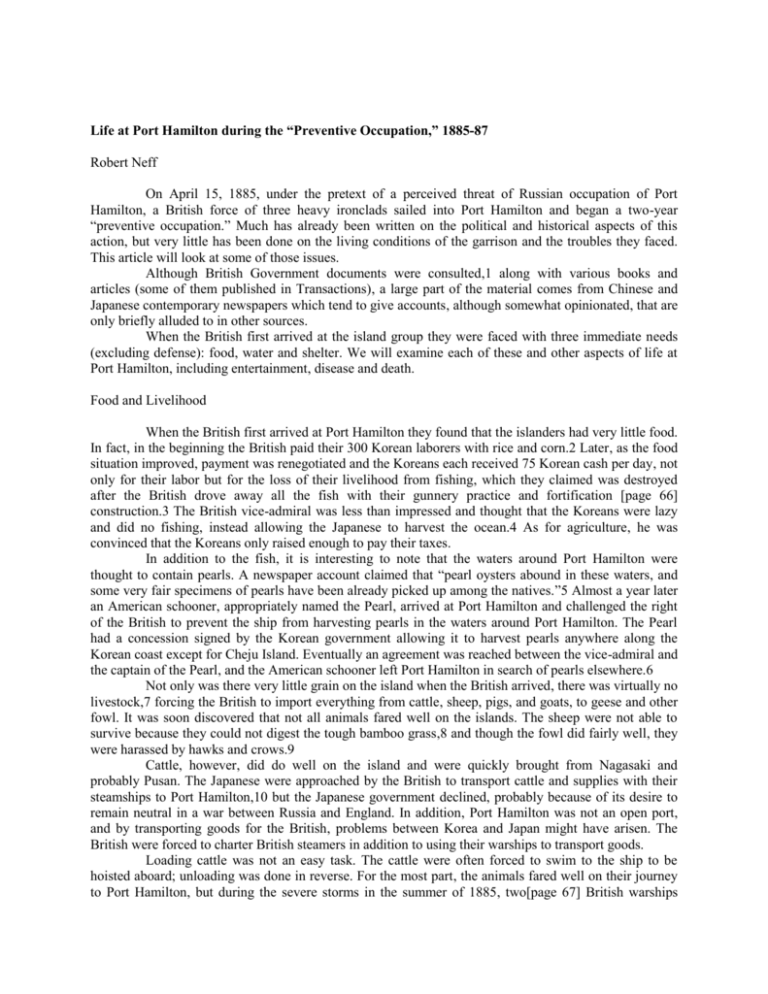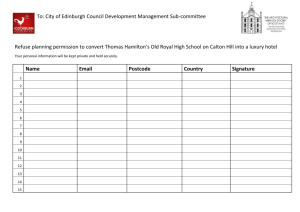Life at Port Hamilton during the "Preventive Occupation," 1885-87
advertisement

Life at Port Hamilton during the “Preventive Occupation,” 1885-87 Robert Neff On April 15, 1885, under the pretext of a perceived threat of Russian occupation of Port Hamilton, a British force of three heavy ironclads sailed into Port Hamilton and began a two-year “preventive occupation.” Much has already been written on the political and historical aspects of this action, but very little has been done on the living conditions of the garrison and the troubles they faced. This article will look at some of those issues. Although British Government documents were consulted,1 along with various books and articles (some of them published in Transactions), a large part of the material comes from Chinese and Japanese contemporary newspapers which tend to give accounts, although somewhat opinionated, that are only briefly alluded to in other sources. When the British first arrived at the island group they were faced with three immediate needs (excluding defense): food, water and shelter. We will examine each of these and other aspects of life at Port Hamilton, including entertainment, disease and death. Food and Livelihood When the British first arrived at Port Hamilton they found that the islanders had very little food. In fact, in the beginning the British paid their 300 Korean laborers with rice and corn.2 Later, as the food situation improved, payment was renegotiated and the Koreans each received 75 Korean cash per day, not only for their labor but for the loss of their livelihood from fishing, which they claimed was destroyed after the British drove away all the fish with their gunnery practice and fortification [page 66] construction.3 The British vice-admiral was less than impressed and thought that the Koreans were lazy and did no fishing, instead allowing the Japanese to harvest the ocean.4 As for agriculture, he was convinced that the Koreans only raised enough to pay their taxes. In addition to the fish, it is interesting to note that the waters around Port Hamilton were thought to contain pearls. A newspaper account claimed that “pearl oysters abound in these waters, and some very fair specimens of pearls have been already picked up among the natives.”5 Almost a year later an American schooner, appropriately named the Pearl, arrived at Port Hamilton and challenged the right of the British to prevent the ship from harvesting pearls in the waters around Port Hamilton. The Pearl had a concession signed by the Korean government allowing it to harvest pearls anywhere along the Korean coast except for Cheju Island. Eventually an agreement was reached between the vice-admiral and the captain of the Pearl, and the American schooner left Port Hamilton in search of pearls elsewhere.6 Not only was there very little grain on the island when the British arrived, there was virtually no livestock,7 forcing the British to import everything from cattle, sheep, pigs, and goats, to geese and other fowl. It was soon discovered that not all animals fared well on the islands. The sheep were not able to survive because they could not digest the tough bamboo grass,8 and though the fowl did fairly well, they were harassed by hawks and crows.9 Cattle, however, did do well on the island and were quickly brought from Nagasaki and probably Pusan. The Japanese were approached by the British to transport cattle and supplies with their steamships to Port Hamilton,10 but the Japanese government declined, probably because of its desire to remain neutral in a war between Russia and England. In addition, Port Hamilton was not an open port, and by transporting goods for the British, problems between Korea and Japan might have arisen. The British were forced to charter British steamers in addition to using their warships to transport goods. Loading cattle was not an easy task. The cattle were often forced to swim to the ship to be hoisted aboard; unloading was done in reverse. For the most part, the animals fared well on their journey to Port Hamilton, but during the severe storms in the summer of 1885, two[page 67] British warships transporting livestock noted that the bullocks had a “bad time” on the way over.11 Once the animals arrived at Port Hamilton they were off-loaded on Sodo Island where the fleet’s slaughterhouse was located. Because there was very little water on Observatory Island where the garrison was located, the cattle were kept on Sodo and tended to by Koreans until the animals were needed, then slaughtered and butchered. Although I have no evidence, I believe the cattle were butchered by the British and not the Koreans. Later accounts from other parts of Korea indicate that the Europeans had a strong aversion to the methods Koreans used in butchering and preparing meat. There were other animals as well: a couple of cocker spaniels are evident in some of the pictures, employed as hunting dogs and companions. Evidently geese were also present and perhaps used as sentries,12 and chickens undoubtedly added to the garrison’s diet with their eggs and flesh. Water Water was a main concern for the garrison. When the British first arrived on Observatory Island where the garrison was located, they were surprised to find that it was uninhabited. The reason soon became clear. The island had some water, but most of the streams dried up during the summer and those that did not were determined to have unsafe water. The garrison solved this problem by keeping one gunboat on station to condense water which was then dragged up the hill to the barracks.13 In addition, several large tanks were removed from the warship HMS Audacious and used to store emergency water. Later, Vice-Admiral Hamilton requested that the condensers aboard the Opossum, a ‘contagious’ hospital ship stationed in Hong Kong, be removed and shipped to Port Hamilton for the garrison’s use. Whether this request was granted or not is unknown. Here is an example of how severe the water problem was. In June 1886, Vice-Admiral Hamilton, concerned about the safety of his garrison, ordered grenades supplied so that the barracks could be destroyed in case of fire. It was deemed impossible to fight the fires with the limited amount of water available. [page 68] Shelter Shelter was a grave concern for the garrison. It consisted of about 100 marines in addition to the sailors aboard their ships. When the first marines arrived on the island they lived in small tents pitched on the bare slopes of a hill overlooking the anchorage, exposed to the powerful winds that roared through the harbor. During the first couple of months of the occupation, a great deal of timber was transported to Port Hamilton, but it was mainly used in building defenses (booms), and the support buildings. These support buildings consisted of a small shack used as the telegraph operator’s hut, two small warehouses, and a gun cotton magazine. Telegraph service was established in late May 1885 when a cable was laid between China and the garrison. The two telegraph operators were quartered aboard the warship HMS Merlin until their prefabricated hut was transported to the garrison from Hong Kong. Their equipment was initially kept in a small shed.14 In late July a severe typhoon struck the islands, ripping the tents and threatened to dash the warships ashore. The vessels had to keep their steam up and be double anchored just to maintain their positions. After the storm it was apparent that the garrison needed stronger and more permanent housing, and work began on the ten or more wooden barracks. Most likely the buildings were put up by the British with the assistance of the Koreans. Although these structures were clean and much sturdier than the tents, they were not weatherproof. The buildings leaked, allowed the cold air and the elements to enter, and needed to be caulked. They were also inadequately heated; during that first winter “the officers and men lived completely in their great coats to keep themselves warm and dry.”15 Off-handedly the vice-admiral noted that the hardships of the winter had toughened his men and officers, but he didn’t wish to see them endure another winter under such conditions. After the telegraph cable was damaged and rendered inoperable, the telegraph office was converted into a kitchen/mess hall for the garrison. The building was too small and the stove inadequate for the number of men that the mess hall served. A ‘contagious hospital’ was also planned for the garrison, but it is unclear whether it was built, especially after Port Hamilton proved not conducive to the general health of the garrison. [page 69] The garrison commander tried to improve the living conditions for the men by ordering additional heaters, and also made a contract with Mr. Tah Lee, a Chinese man, to repair and strengthen the barracks.16 So severe were the conditions that a newspaper noted: “The spot on Observatory Island on which the huts for the present garrison of Marines are built, is exposed to gales so violent at times that the huts are held down by heavy chains passed over the roofs and anchored to the ground.”17 Entertainment Life on Port Hamilton was extremely boring. Because of its isolation there was little in the form of entertainment, especially in the later part of the occupation when the Russians were no longer feared. The enlisted men often put on plays and musicals to amuse themselves and their officers. Perhaps some of their inspiration came from the “Port Hamilton Circulating Library.” A supply of books, described as “somewhat ancient light literature,” was donated by the foreign community at Nagasaki and then delivered by British warship to the men at Port Hamilton, who viewed the books as a “god-send to the whole fleet”18 Once the Russian threat faded, the men were rotated back to Shanghai, Chefoo, or Nagasaki for shore leave.19 The officers “shouldered spade and pick” and built a tennis court during the first months of the occupation, and often spent their leisure time playing tennis.20 But many desired a more manly sport. A group of these officers accordingly got together and formed the “Port Hamilton Game Club,” a rather grand name considering there was no wildlife on the islands except crows, hawks, and poisonous snakes.21 They pooled their money to introduce live pheasants, brought to the islands from China. One of the officers chosen to buy and import the pheasants was a “Wast Country Spartsman” who brought back eighteen birds to help begin the operation—unfortunately seventeen of the birds were males. Despite this early mistake, the birds and subsequent shipments did fairly well and quickly reproduced. By October 1886,more than 200 pheasants had been imported,23 and quickly reproduced so that the islands were almost overstocked with the birds, “as the natives do not touch them, their only enemies being the eggstealing crows in the spring, and the kites and hawks that migrate over to the islands in the autumn.”24[page 70] In addition to the pheasants, quail were found in great numbers, and were hunted by the men while the pheasant were still quite rare. A British officer who hunted throughout the Far East had this to say about hunting quail on Port Hamilton: “In the month of October, there is an annual invasion of quail; and with a smart dog, it is quite possible to make exceedingly good bags of these little birds; as many as five hundred having been shot by one gun, in part of a season.”25 Others took the opportunity to work with their hands. Some of the marine officers took great pleasure in establishing little farms complete with vegetable gardens, and took great pride in their small farms of pigs, goats, sheep and fowl of all kinds.26 Relations with the Koreans The British naval base was located on the center island, Observation Island, which was uninhabited by Koreans, who, except for working with the sailors, had very little contact with them. The sailors and marines were under a “strict non-intercourse system” with the Koreans, not only in an effort to prevent any incidents from occurring, but also as a preventive measure against disease. The Korean women were extremely shy, and rarely seen by the British. “At the approach of a European, the women all hide themselves, whether fearing the evil eye or from being maltreated by the Europeans in the past is not known.”27 The fleet surgeon noted “Any woman one chances to meet darts away like a hare, and one is lucky to get more than a glimpse of a pretty face, a short jacket and a kind of ballet-girl petticoat disappearing through a hole in a wall.”28 The British were appalled at the Korean islanders’ sanitation. A trip to the villages, in the words of one British officer, was “not a pleasant undertaking.” The villages were filthy and reeked of the garbage and offal that was left to rot in the streets in the hopes that it would be eaten by the stray dogs or washed away by one of the storms. The Korean islanders enjoyed drinking, a fact noted by Cyprian Bridge in his report of 1875. A. G. Wildley, fleet surgeon for the Port Hamilton garrison, also commented about the Koreans’ penchant for drinking: “It is a lamentable fact that by sunset the majority of the islanders are drunk with saki, mirthfully or otherwise.” Yet, despite their [page 71] frequent drunkenness, I could find no accounts of trouble erupting between the Koreans and British. Another vice that the Koreans had was tobacco. Tobacco was introduced to Korea in the late sixteenth century, probably by the Japanese. Hendrik Hamel noted that even children four or five years of age smoked it, and that it was rare to encounter people who did not.29 British officers who visited the villages were often followed by a dozen Korean boys who pestered them in broken English for tobacco. If they were refused, the youths cursed at the officers in “volleys of British oaths” that they had undoubtedly learned from previous visitors.30 There is no question that the Koreans were intelligent. When James Scott negotiated land leases with the local magistrates he was a little surprised that they had “considerable knowledge of political affairs affecting Corea,” and they also sought to avoid paying taxes to the Korean government.31 As mentioned above, there were several Koreans that were able to learn English as a result of their intercourse with the British. One Korean who was employed as a scavenger in the British camp for less than a year learned enough English to speak and write well enough to be understood by his employers.32 Although there are many accounts from early Westerners about Koreans stealing and lying, there is only one reference to theft during the British occupation. A British officer, Captain Powlett, stated that the Koreans had “thieving propensities”33 but did not elaborate. It seems strange that the British would not have noted it if it was such a common occurrence. Many of the Englishmen, especially the officers, had very negative impressions of the Koreans. Some described them as “lazy,” “a filthy race,” and “far from acceptable guests on board a man-of-war.” Captain Powlett even noted superiorly: “There is no room for civilization and barbarism to exist side by side.”34 Despite the negativism that the British had for the Koreans, the Koreans seemed to have had good feelings for the British. According to Vice-Admiral Hamilton, a Korean magistrate thanked Captain Powlett for the good relations between their two people, “asking at the same time for more work” for his people. When the British left in January 1887, they claimed that the islanders were sad to see them leave. [page 72] Disease Many of the Korean islanders had smallpox and cholera, and epidemics in 1885-86 were especially virulent in which thousands of Koreans across the country and a few foreigners lost their lives.35 A popular illustrated weekly newspaper had a front page depiction of a British officer’s day on shore at Port Hamilton that demonstrates the fear these sailors had of contracting disease. In one frame he is shown holding a bunch of medicinal herbs in front of his nose and warding off a group of half-naked Korean children with a stick because there was “Small Pox among the natives.” The next frame shows him cowering at one end of a boat as the Koreans transport him back to his garrison.36 It was probably because of this enforced segregation that the British were able to avoid the brunt of this disease. However, this remains open to interpretation. In late August 1885, at the height of the cholera season in Korea, the HMS Audacious sailed from Port Hamilton and visited Yokohama, Japan. It was noted that several of the officers were extremely sick and one officer, Capt. Liardet of the marines, died of malarial fever and was buried in Kobe, Japan. Lieutenant Hawker died en route and was buried at sea.37 Naval Instructor A. T. Knight and three other officers were confined to the Naval Hospital for treatment of sunstroke and fever—Knight died shortly after being admitted. These were not the only fatalities. Just a few days later the HMS Cleopatra also suffered an outbreak of fever aboard ship. P. T. M. Hughes, the assistant paymaster, was suddenly stricken with fever, slipped into unconsciousness, and died. A week later Acting Sub-Lieutenants E. A. Day and A. P. Camber were similarly stricken with fever. Their fates are unknown.38 There is no conclusive proof that these men fell ill while at Port Hamilton,but the North China Herald did note: “It was naturally thought that Port Hamilton would be a healthy place, but, possibly from undue exposure up there, the officers seem to have suffered somewhat severely. Also: “[I]t has been matter for some wonder that during the warm summer months so many ships should have been cooped up in the confined harbours of Port Hamilton and Nagasaki, instead of being detached to the other port[s].”39[page 73] Death Death is a constant companion for members of the military, and the garrison at Port Hamilton was no exception. Nine men died and were buried at Port Hamilton during the British occupation,40 some due to natural causes, but most to accidents. Perhaps the best known accident involved Private Ward, a young British marine. On May 16, 1886 an enterprising Japanese fisherman arrived and set up camp with five Japanese women on Observatory Island to dry his fish. Even though it was well established that the Japanese had used the island in the past, this particular fisherman seems to have had more than fishing on his mind Word soon spread amongst the young sailors and marines that female company could be purchased. On the first night, three young marines, not having been with women for some time, tried to sneak over to the Japanese camp, but were discovered and caught. The guard was increased, but early on the morning of May 18, twelve marines launched two boats and tried to make their way to the Japanese camp. They were soon discovered missing and a search was started. When they were spotted, another boat was sent out to intercept them and bring them in. The companionship-starved marines, seeking to evade capture, inadvertently capsized their boat, dumping six of them into the water. Five of the marines were rescued, but the sixth, Private Ward, was unable to swim and with the “considerable weight of silver dollars in his pockets” drowned.41 An initial search failed to turn up the body and the garrison commander offered a five-dollar reward for its recovery. Eventually the body was recovered and the hapless youth laid to rest. Other accidents occurred in the line of duty. In July 1885 the warship Cleopatra was transferring coal from the steamship Merionethshire at night. The Cleopatra used its new electric light to aid in the operation, but due to an electrical problem, the resistance box suddenly burst into flames at two in the morning. Fortunately the crew was able to extinguish the fire with a water hose after about twenty minutes.42 There were no casualties or injuries, but not all accidents ended as well as this one did. In early March 1886, a training accident aboard the HMS Albatross claimed two British sailors’ lives. The Albatross had just finished target practice with its Nordenfeldt guns in the vicinity of Port Hamilton. The [page 74] sailors, in a rush to store their equipment and return to port, inadvertently left a live round in one of the guns in the bow. None remembered it. As the ship was returning to port a rope struck the charging handle of the gun and the round went off, mortally wounding two men and severely injuring a third. The third man eventually recovered, but William J. Nubbay, a sailor, and Charles Dale, a ships’ boy only 17 years old, soon died of their wounds and were laid to rest.43 On June 11 another weapon firing accident occurred, this time aboard the Cleopatra. The ship was engaged in prize firing when one of the guns suddenly discharged while being loaded. Private Olive, a marine, was killed instantly and Lance Corporal Green had part of his right arm blown off and suffered severe head injuries. Imperfect sponging was thought to be the cause of the accident.44 The Cleopatra returned to Port Hamilton and the unfortunate marine was buried at five o’clock the same evening. The doctors did what they could for Lance Corporal Green, including amputating his arm above the elbow, but the wounds proved too serious and he died the following day and was buried.45 The last Westerner to die at Port Hamilton during the “preventive occupation” was buried on June 26. W. M. Bowles, a stoker aboard the HMS Champion died of an aneurism while at his station.46 There were three others who were buried at Port Hamilton whose causes of death are unknown. They are Frederick C. Skinner, a ship’s boy aboard the HMS Audacious, John D. Mackett who is listed as a writer aboard the HMS Pegasus, and Samuel Smith, Third Engineer aboard the steamship Merienethshire, which had been contracted by the British government to transport goods to the garrison. Conclusion The British finally ended their occupation of Port Hamilton in February 1887. The buildings were advertised for sale in newspapers in Nagasaki and Shanghai, but as one paper noted: “Tenders are still ‘wanted’ for the purchase of the British Government property at Port Hamilton. Notwithstanding the fact that every inducement and facility have been offered to intending purchasers by the British naval authorities, we believe that not a single offer has been received,”47 Eventually all that could be moved and salvaged was loaded aboard steamers and [page 75] transported away. The British left behind more than 700 bricks, which they abandoned to the Koreans, and the telegraph cable, which they later sold to the Eastern Extension Telegraph Company and was moved to Shanghai in July 1887. And, of course, they left the graves of nine Englishmen. REFERENCES 1. These include: Foreign Office Documents regarding the Correspondence Respecting the Temporary Occupation of Port Hamilton, March 1887, China Number 1 [C.-4991.], Prints 5207 (1885),5382 (1886),and 5633 (1887) [hereafter Correspondence]. 2. According to James Scott: “On the arrival of our fleet in April last, the villagers were in a most destitute condition, their supplies of food being almost exhausted. Labour was therefore paid for in rice, 9 lbs. being allowed to each workman.” (James Scott to Consul-General Aston in Seoul, Aug. 31, 1885, in Correspondence. See also Vice-Admiral Sir W. Dowell to the Secretary to the Admiralty, May 28, 1885, in Correspondence.) 3. Scott to Aston, Aug. 31, 1885, in Correspondence. 4. This seems in contradiction of what Cyprian Bridge wrote about his journey to the islands in 1875: “A few small fishing-craft were standing into the bay, their white or pale-blue pennons fluttering in the gentle breeze from slender staves erected in their high-pitched sterns.” Captain Belcher stated: “Their occupation seemed to be solely fishing and that they had a tolerable fleet of well-found substantial boats.” (Sir Edward Belcher, Narrative of the Voyage of the H.M.S. Samarang (London, 1848), 352. 5. North China Herald, Aug. 7, 1885. 6. Robert Neff, “The American Pearl in Choson,” Korea Times, Sept. 18, 2004. 7. Cyprian Bridge noted in 1875 when he visited the island that the only domesticated animals were pigs and dogs. 8. Captain Powlett to Vice-Admiral Hamilton, April 7, 1885, in Correspondence. 9. The Graphic, Feb. 12, 1887, cited in S.J. Whitwell, “Britons in Korea,” Transactions of the Korea Branch of the Royal Asiatic Society 41 (1964): 54. 10. Scott to Aston, Aug. 31, 1885, in Correspondence. 11. North China Herald, July 31, 1885. 12. The Graphic, Feb. 12, 1887, in Whitwell, 54. 13. Powlett to Hamilton, April 7, 1885, in Correspondence. 14. Vice-Admiral Sir W. Dowell to the Secretary to the Admiralty, June 3, 1885, in Correspondence. 15. Vice-Admiral Hamilton to Admiralty, June 2, 1886, in Correspondence. 16. North China Herald, Aug. 6,1886; Japanese Gazette, Aug. 4,1886. 17. North China Herald, Oct. 6,1886. [page 76] 18. Japanese Gazette, Aug. 4, 1886. 19. When the Nautilus, an Austrian warship, visited Port Hamilton in June 1885, Captain Spetzler, the commander, noted that: “Most of the English forces were absent from Port Hamilton because they took in celebrating the honor of the so called “Seventh Imperial Prince” in Chefoo and Port Arthur and afterwards they went on to Nagasaki.” 20. North China Herald, July 3,1885; The Graphic, Feb. 12,1887, in Whitwell, 54. 21. William Blakeney, On the Coasts of Cathay and Cipango Forty Years Ago (London: Elliot Stock, 1902), 163. The crew of the HMS Actaeon traveled to Port Hamilton in May 1859 and noted that the islands had many vipers—”one was caught measuring 6 feet 8 inches.” 22. Christopher Cradock, Sporting Notes in the Far East (London: Griffith, Farran, Okeden & Welsh, 1889), 128; Robert Neff, “Port Hamilton Sportsman Club,” Korea Times, May 1, 2004. 23. North China Herald, Oct. 6, 1886. 24. Cradock, 128. 25. Ibid. 26. The Graphic, Feb. 12, 1887, in Whitwell, 54. 27. Vice-Admiral Hamilton to the secretary to the Admiralty, June 1, 1886, in Correspondence. 28. The Graphic, Feb. 12, 1887, in Whitwell, 54. 29. Vibeke Roeper and Boudewijin Walraven, ed., Hamel’s World: A Dutch-Korean Encounter in the Seventeenth Century (Amsterdam: Sun Publishers, 2003), 151. 30. The Graphic, Feb. 12,1887,in Whitwell, 54. 31. Scott to Aston, Aug. 31, 1885, in Correspondence. 32. The Graphic, Feb- 12, 1887, in Whitwell, 54. 33. Powlett to Hamilton, April 7, 1885, in Correspondence. 34. Ibid. 35. Robert Neff, “Small Pox: Child Killer,” Korea Times, Feb. 28, 2004; Robert Neff; “Cholera, the Rat Disease,” Korea Times, July 10,2004. 36. The Graphic, Dec. 11, 1886. 37. North China Herald, Sept. 11, 1885. 38. North China Herald, Sept. 25, 1885. 39. North China Herald, Sept. 11, 1885. 40. There are actually ten Englishmen buried at Port Hamilton, but one English sailor, A. B. Alexander Wood of the HMS Albion was buried on the island in 1903. Of the original gravestones only the stone for Nubbay and Dale remains, and the wooden cross for Wood; the others have long since fallen. The British government erected a memorial in 1998 upon which the names of the other men were listed in a rededication ceremony. (Whitwell, 27-28.) 41. Secretary of the Admiralty to Sir P. Currie, July 21, 1886, in Correspon-dence. 42. North China Herald, Aug. 7, 1885. [page 77] 43. North China Herald, Mar. 24,1886. 44. North China Herald, July 2,1886. 45. Japanese Gazette, July 14,1886. 46. Ibid. 47. North China Herald, Feb. 9,1887.







